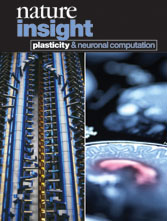If you read these words from Marvin Minsky: "minds are what brains do" and "doing means changing", your brain's fine structure may be durably altered. Such is neuronal plasticity, a concept that has found a home in many areas of neuroscience, from brain repair to learning and memory. But plasticity is not only a reaction to change; it is also a source of change. This Insight considers plasticity as the critical engine of neuronal computation.
Purely elastic systems cannot compute much: imagine an abacus with springs between the beads. But assemble the simplest storing or switching devices, such as Charles Babbage's mechanical gears or silicon-based flip-flops, and you get a universal computer. Living organisms, from bacteria to elephant, are packed with comparable switches, gates and stores. From protein allostery and trafficking to long-range neuromodulation, everything biological produces adaptive computation.
Synapses, for example, change strength in real time, as Bernard Katz observed fifty years ago — not just slowly to sustain learning and memory. And there is a growing appreciation of how much they differ from passive linear junctions. Short-term plasticity allows synapses to decode spike trains, transmitting some and blocking others. And because synapses have distinct histories, a neuron has not one but myriads of outputs, so temporal codes translate into spatial maps.
Therefore, plasticity emerges as perhaps the deepest and most pervasive source of computational power in the brain. The following reviews illustrate this idea from millisecond computations in synapses to life-long information storage in cortex, and from digestive control in crabs to general intelligence and value judgement in humans. Each piece brings together computer and bench neuroscientists to offer a fresh meeting of experiment and theory.
We are pleased to acknowledge the financial support of Merck & Co., Inc., which contributed towards the distribution of this Insight. As always, Nature carries sole responsibility for editorial content and peer review.
